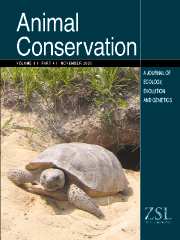Article contents
Belding's yellowthroat: current status, habitat preferences and threats in oases of Baja California, Mexico
Published online by Cambridge University Press: 01 May 1999
Abstract
The Belding's yellowthroat (Geothlypis beldingi) is an endemic species of Baja California Sur confined to the edge vegetation of freshwater at several oases. Information on its current status, distribution and habitat selection, and an analysis of the human-related threats that the species faces at 10 oases are given here. Belding's yellowthroats have disappeared from three historical sites, Santiago, Miraflores and El Triunfo, where they were recorded in the early 1900s. Belding's yellowthroats forage mainly in reed grass and cattails in all oases and were never recorded > 50 m outside the edge vegetation of the water. The main threats we detected to their habitat were cutting of reed grass for rural home construction, burning vegetation, opening trails to the water for cattle, overgrazing of reed grass by horses and burros, and using up the water for agricultural and tourism purposes. Although local populations of the species seem to be common, they are vulnerable because the distribution of the species in southern Baja California is patchy. Populations are in general small and isolated, the bird has habitat-specific requirements, and human-related activity is putting pressure on the habitat of this endemic species. A Multidimensional Scaling Analysis showed that southern populations are likely to be more severely affected than northern ones.
- Type
- Research Article
- Information
- Copyright
- © 1999 The Zoological Society of London
- 12
- Cited by


